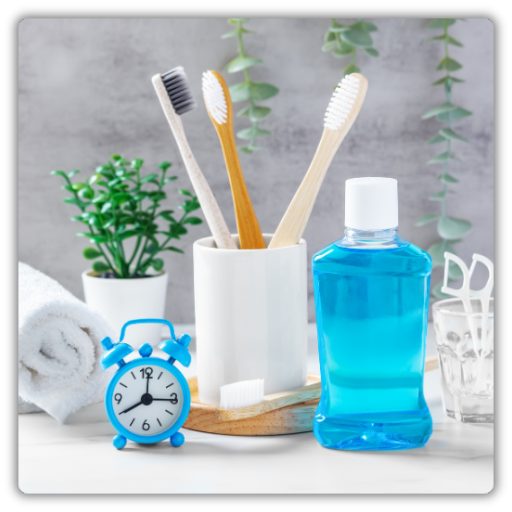
Whether you’re at a meeting or chatting with friends, realizing your breath might be off can make you feel self-conscious. Often, the causes of bad breath tie back to oral health issues like poor dental care or even gum disease. The good news? With a focus on good oral hygiene and an understanding of what can lead to bad breath, you can find effective treatment and get back to feeling your best.
KEY POINTS
Bad breath, or halitosis, is often caused by poor oral hygiene, dry mouth, certain foods, and underlying health conditions such as acid reflux or gum disease.
Symptoms of bad breath include a persistent bad taste, a white or coated tongue, and people frequently offering mints or gum.
To combat bad breath, maintain a good oral hygiene routine, stay hydrated, limit foods that cause odor, and visit the dentist regularly.
Chronic bad breath may indicate a more serious health issue, so it’s important to consult a doctor if home remedies don’t provide relief.

Pop in your email below, and we’ll zip it straight to your inbox so you never lose it!
What’s Causing That Funky Breath?
Bad breath doesn’t just appear out of nowhere. It’s usually a sign that something’s off, whether it’s your oral health routine or an underlying condition. Here’s a breakdown of some of the usual suspects that contribute to bad breath:
- Poor Oral Hygiene
When you skip brushing or flossing, plaque and food particles hang around in your mouth, creating a perfect environment for bacteria in the mouth to thrive. These bacteria produce sulfur compounds, which—let’s face it—can cause stinky breath that smells a lot like rotten eggs. - Dry Mouth (Xerostomia)
Saliva is like your mouth’s personal cleaning crew. When you don’t produce enough saliva, whether from dehydration, medications, or even just sleeping with your mouth open, odor-causing bacteria get comfortable and stick around longer than they should. This makes it harder to keep your mouth clean and fresh. - Diet Choices
Eating certain foods like garlic, onions, or spicy dishes can affect your breath long after the meal is over. Their compounds get absorbed into your bloodstream and are released when you breathe out, contributing to the causes and unpleasant odor of chronic bad breath. These foods can stick around in your system, leaving you with lingering breath odor. - Health Issues
Sometimes, bad breath isn’t just about what’s in your mouth. Health issues like acid reflux, sinus infections, or oral health conditions (like decay or gum disease) can also play a role. These can lead to bad breath by introducing bacteria or chemicals that cause the symptoms of halitosis or other unpleasant odors. Even conditions like diabetes can contribute to bad breath by affecting your body’s balance.
Symptoms: How Do You Know If It’s Halitosis?
Let’s be real—most of us can’t smell our own breath, no matter how many times we try the “hand-cup” sniff test. If you’re wondering if halitosis might be the cause of your persistent bad breath, here are a few signs to watch out for:
- A persistent bad taste in your mouth that just won’t go away.
- People offering you mints or gum a little too often.
- A white or coated tongue, often from bacteria that remain in your mouth.
If you’re still unsure, ask a friend who’ll give you the truth—the brutal truth—because sometimes, it’s hard to find the cause on your own. It might be a small sign of tooth decay or an oral health condition, or even something more serious like gastroesophageal reflux disease (GERD), which causes an unpleasant odor that doesn’t fade. If your breath smells even after brushing or bacteria in your mouth is still there, it’s a good idea to check with your dentist or doctor to find the root cause.
Solutions: Kick Bad Breath to the Curb

Now that you know what’s causing your bad breath, let’s talk solutions. If you’re experiencing bad breath, here’s how to treat and prevent it from making a return:
- Step Up Your Oral Hygiene Game
Make sure you’re brushing your teeth twice a day with fluoride toothpaste. Don’t skip flossing—food particles and bacteria love to hide between your teeth and gums. A tongue scraper can also help clear away bacteria from the surface of the tongue, one of the places where bad breath can start. - Hydrate Like a Pro
Drink plenty of water throughout the day. Staying hydrated doesn’t just keep you feeling good—it also helps wash away food particles and bacteria that can cause your halitosis. - Watch Your Diet
Limit foods that are associated with bad breath, like garlic and onions. Instead, add more crunchy fruits and veggies—think apples and carrots. They act as natural scrubbers for your teeth and can help keep your breath fresher for longer. - Use Mouthwash
A good mouthwash can give you that instant fresh breath boost. But remember, it’s not a replacement for brushing and flossing. Use it as part of your full routine to help treat halitosis and keep your mouth feeling fresh. - Don’t Skip Dentist Visits
Regular checkups are essential for the treatment of oral health issues. Your dentist can help pinpoint the cause of your halitosis and address it before it turns into something bigger.
When to See a Doctor
If you’ve tried everything to treat bad breath and it’s still lingering, it might be time to dig a little deeper. Chronic halitosis or bad breath can sometimes point to an underlying cause or medical issue that needs professional attention. A healthcare provider can help identify the cause of the problem and work with you to develop a treatment plan that targets the symptoms and causes. If it’s not just about mouth odor, they’ll use the right measurement and treatment to get to the heart of the issue and ensure you’re on the path to fresher breath. Don’t hesitate to seek help if you feel like something’s off—it’s all about finding the right halitosis treatment and taking action to fix it.
The Bottom Line
Bad breath doesn’t have to remain an embarrassing mystery. By understanding the cause of halitosis and identifying possible causes, you can take proactive steps to fix it. Whether it’s morning breath or breath to smell like it’s caused by certain foods or bacteria in the back of your throat, you don’t have to live with it. With the right treatment for halitosis, you can confidently say goodbye to bad breath and enjoy fresher, more confident interactions. Remember, your mouth isn’t just for talking—it’s also a gateway to your overall health, so treat it with care!











